The Walnut: [Complete Guide to Grow It Successfully in your Garden]
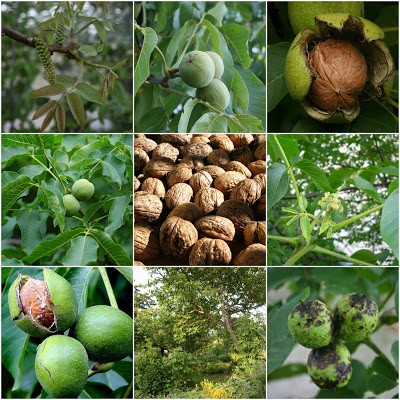
A walnut (Juglans regia) is a large tree that produces one of the most consumed nuts in the world: walnuts.
It is a species of the Juglandaceae family that produces various species and all respond to slightly different environmental conditions.
Important: It is established with wide roots, so it needs to be planted far from any type of construction.
Are you interested in having one of these in the garden of your house? Well, pay attention because with this guide success will be assured.
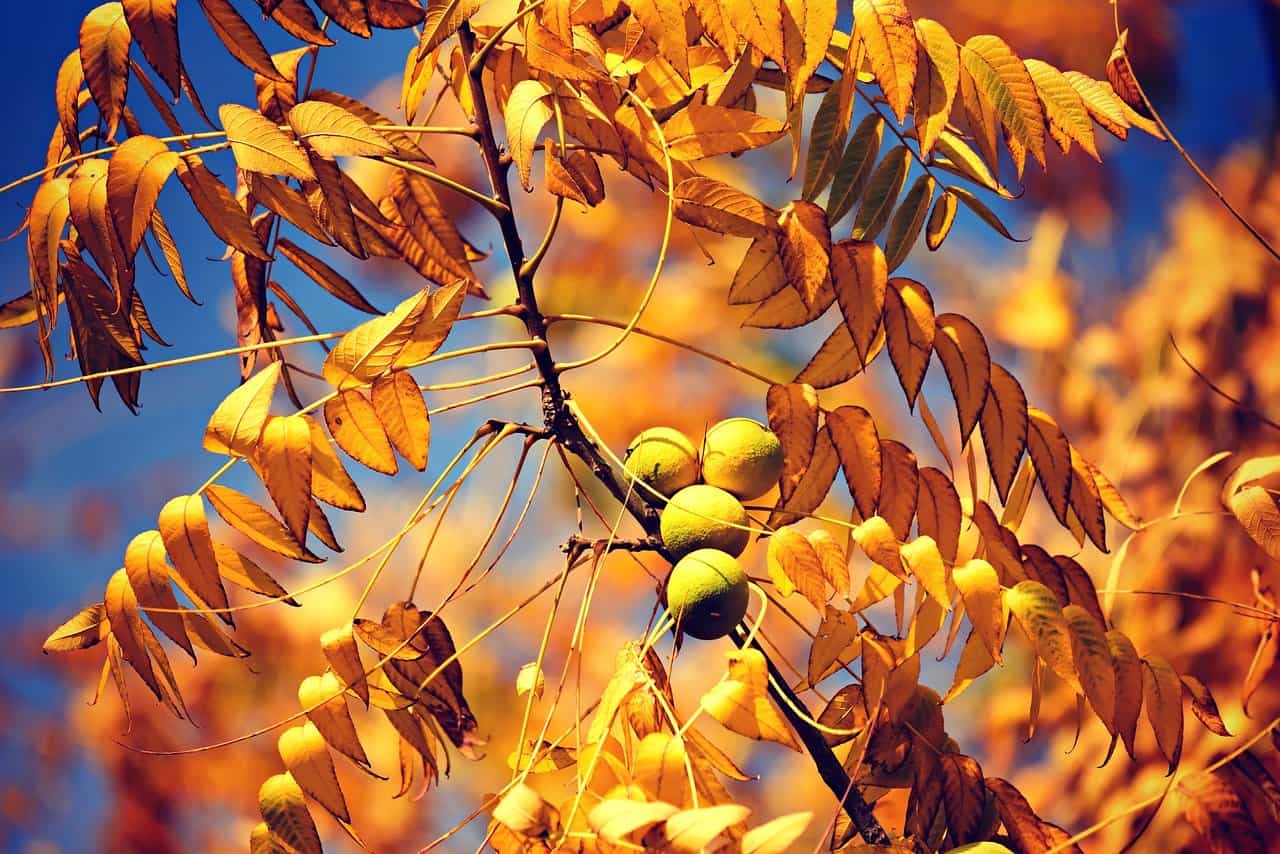
Important points when planting a Walnut
- When? in autumn.
- Where? Outdoors, where it always receives sunlight. Cold climates, desert and/or tropical climates are not recommended.
- How do we prepare the land? Stirring thoroughly and moistening beforehand.
- How should we water? By drip, in a focused way.
- How often do you have to water? In abundant flowering and fruiting. The rest of the time when the land is a little dry.
- What pests and diseases do they have? Worms and aphidscan be seen as pestsIn diseases we have anthracnose and walnut ink.
Walnut Characteristics
The walnut is a fabulous tree. It grows and develops in cold and mountainous climates. Therefore, we do not recommend that you try its cultivation if you live in an area with a tropical or Mediterranean climate.
The walnut tree can reach more than 30 meters. Also, with the right conditions, it can grow very fast.
There are many varieties of walnut, such as:
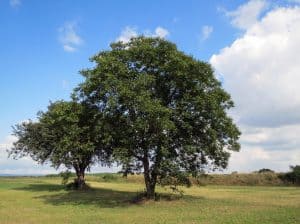 Walnut Mollar.
Walnut Mollar.- Walnut Moyete.
- Walnut Barthere.
- Walnut Franquette.
- Walnut Of the birds.
- Common Walnut.
- Parisian walnut.
- Walnut Pico de partridge.
- Late Walnut.
- Early Walnut.
- Walnut Bijoux.
Where to plant a walnut?
 The walnut tree should be planted in a large area, outdoors, where it receives a good amount of sunlight on a daily basis.
The walnut tree should be planted in a large area, outdoors, where it receives a good amount of sunlight on a daily basis.
It is also important that the land has a good level of drainage because, within its care, abundant irrigation is a fundamental part.
In the same way, it is necessary to make sure that the chosen place is of good depth to give tranquility of expansion to its roots.
Finally, it is necessary that the pH measurement generates a neutral level.
When should a walnut tree be grown?
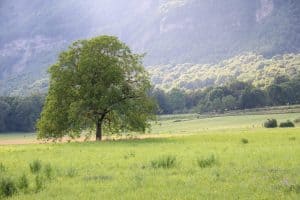 The recommended time for planting the walnut tree is during the fall.
The recommended time for planting the walnut tree is during the fall.
It is necessary to ensure that it is in the first days, when temperatures drop but there is no risk of early frosts.
How long does it take for a walnut tree to bear its first fruits?
The first productions can be generated up to five years after planting the tree, as long as it has been done by grafting.
It is also essential to have maintained all the recommended care that allows it to be in optimal conditions.
In the case of larger productions, the time usually reaches up to 30 years after planting.
The abundant production of walnut requires time, but it makes the achieved result very worthwhile.
What water needs do you have?
 The walnut is a tree that does not support drought under any circumstances, hence it is essential to maintain a good irrigation program.
The walnut is a tree that does not support drought under any circumstances, hence it is essential to maintain a good irrigation program.
This process becomes even more important in the month and a half that follows the start of flowering.
It is also necessary to take great care of this aspect in the stage of fructification and growth of the fruit because it will be what will tell if it will have a good size or not.
In general, abundant localized drip irrigation is recommended. That is, directly on the base of the tree.
How to plant a walnut tree step by step?
- The planting of the walnut begins with the correct preparation of the land that must be removed and given depth so that the soil is loose.
- It is necessary to water days in advance to ensure that the soil is moist at the time of planting the walnut.
- The most recommended mechanism to carry out the plantation is through the use of plants acquired in agricultural stores or nurseries. These have been prepared according to the climatic conditions of the area to have a better development.
- It is important to take into account that the roots of the walnut tree are very delicate, so the ground must be very well prepared before removing it.
- In addition, it must be placed very carefully to prevent the roots from being damaged, as this could expose it to diseases.
- After completing the planting of the walnut tree in the ground, you must fill the free spaces with aerated soil and water abundantly.
- Unlike other species that it is recommended to press to avoid air pockets, in the case of walnut it will be the opposite.
- At the end of this whole process, it is a good idea to apply mulch to ensure that the soil maintains the most favorable level of humidity.
If you want to go deeper, you can see: Walnut cutting.
How do we harvest the nuts?
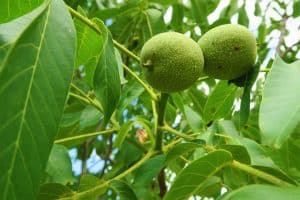 Walnuts, as we know them, are produced through a green shell fruit. When harvest time arrives (from August onwards), the shells begin to open naturally.
Walnuts, as we know them, are produced through a green shell fruit. When harvest time arrives (from August onwards), the shells begin to open naturally.
In this way, we will have access to the interior of the fruit, which is right where the nut that we will easily remove is located.
Since there is a possibility that these could fall, it is very important to keep the base of the plant clean of dry leaves.
walnut watering
Important points when watering a walnut tree:
- Irrigation frequency: 5 times a week if the tree is in sandy soils and 3 times a week if the tree is in clay soils.
- Irrigation method: drip or flood in some cases.
- Optimum time of day for irrigation: at dawn.
- Identify excess water: neck and root rot.
- Identify lack of water: leaves that turn yellow and fall, knots that do not develop, fruits that remain small.
What irrigation needs do walnut trees have?
It has periods of water demand that coincide with the arrival of summer. From the moment of planting, to the flowering and fruit formation cycles, the needs are the highest.
The establishment of a good irrigation mechanism will help ensure that the supply of liquid is in accordance with the requirements of the plantation, since it is not identical in all cases.
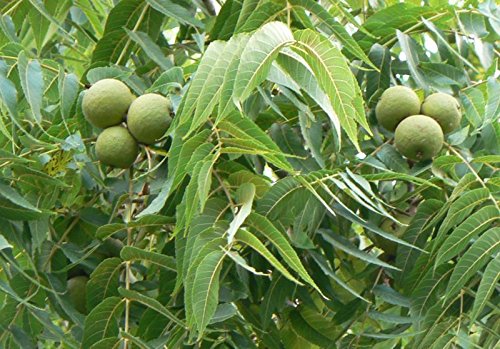
In any case, the irrigation frequencies that we can recommend will vary throughout the year depending on the surrounding conditions. For example, on rainy days, irrigation will be almost unnecessary because the trees will naturally take what they need.
How can we detect lack of irrigation in walnut trees?
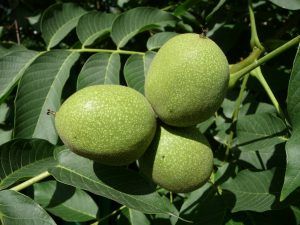 When young walnut trees do not receive the amount of water that corresponds to them, they will be unable to grow normally, seeing short and flattened knots.
When young walnut trees do not receive the amount of water that corresponds to them, they will be unable to grow normally, seeing short and flattened knots.
If the tree has beautiful and abundant foliage, it is quite likely that it will begin to yellow and fall off the tree.
In cases where the plant is in full production, the fruits will be affected, developing little and leaving a hard and small nut.
How often should we water the walnut trees?
One of the main considerations to have when watering walnut trees is the type of soil.Establishing the frequency must respond to its drainage capacity.
If the soil is sandy, the irrigations have to be more continuous but with little amount of water, reaching up to 5 a week during the summer. In the case of clay soil, irrigation will have to be less constant and with a greater amount of water, but taking care that it is supplied slowly.
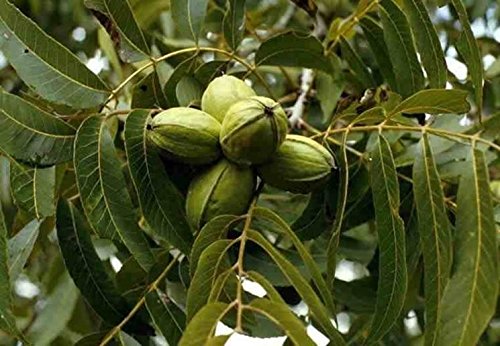
A frequency according to an adult walnut tree in clay soil will be approximately 3 times a week. It must be taken into account that irrigation is especially decisive in the 6 weeks following the start of flowering.
This is because it is at this stage that the formation of the seeds and the creation of the crust begin. After this time, irrigation ceases to be so essential for the quality of the fruit because its growth is based on essential oil, not water.
What is the best way to water walnut trees?
The most recommended way to irrigate walnut trees is by drip, as it allows the right amount of water to be supplied to the base of the tree.This methodology is beneficial for all types of soil and although it requires an initial logistical and economic investment, it will end up being more economical.
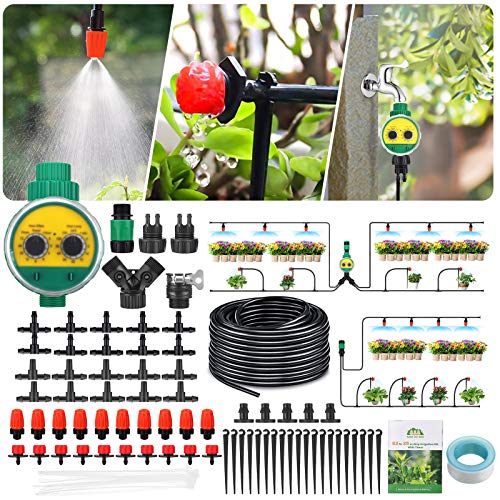
If the cultivation of walnut trees is numerous, it will also make it easier for all the trees to receive the same amount of water, allowing equal characteristics in all the specimens. Walnut trees are also capable of accepting flood irrigation, but great care must be taken with the type of soil.
How do we detect excess water in walnut trees?
Excessive irrigation in walnut trees will cause root rot that will decisively affect the health of the plant.In the case of applying a flood irrigation system, it must be taken into account that the stagnation of water can cause neck rot.
For this reason, it is only recommended for soils that have a high drainage capacity. By applying all these measures, you will have a walnut tree with better characteristics, which will increase even more if you use high-quality water.
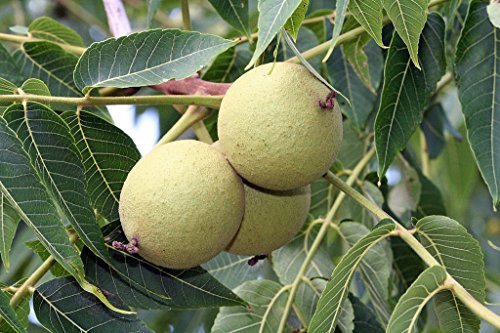
The ideal is to opt for a water with a low salt content because the excessive accumulation of this mineral in the root of the tree could be harmful. Of the rest, it will only be necessary to take care of the fertilizations and the general conditions of the environment (such as the growth of weeds) that can harm the health of the specimens.
What pests and diseases does the walnut tree have?
The walnut tree is very prone to pests and diseases and its prevention begins from the moment the land is selected and planting begins.
The pests
 Among the main pests we have:
Among the main pests we have:
- Walnut worm: attacks the fruits when they are small larvae and then passes to the trunk when ripe. It can be combated through the use of insecticides or pheromone traps.
- Zeuzera: these are caterpillars that cause damage to younger plants, altering normal development. His combat will only be possible to carry out with chemical products.
- Aphids: aphids are the least harmful pest but still exert some level of damage. It must be treated with insecticides.
The diseases
As for diseases, we have the following:
- Walnut ink: it is a disease that is caused by a fungus and directly attacks the roots. If not treated in time, it can cause the death of the tree. In general, it produces symptoms such as: weakness, falling leaves, dry branches, etc. Unfortunately there is no effective treatment. If these symptoms appear, it will be necessary to check the root and remove the parts that show dark spots. When the disease is already very advanced, the only step that will work is the elimination of the tree.
- Rot: also occurs through a fungus that penetrates the roots and causes little fruit production, yellow leaves and dry branches. Some fungicides can be used to combat it.
- Anthracnose of walnut: it is evidenced by spots on the leaves that are dark in color but whose surroundings are yellowish. As it advances, it causes the leaves to fall. Chemical treatment and pruning of the affected parts should be applied to prevent its spread.
verticillium wilt
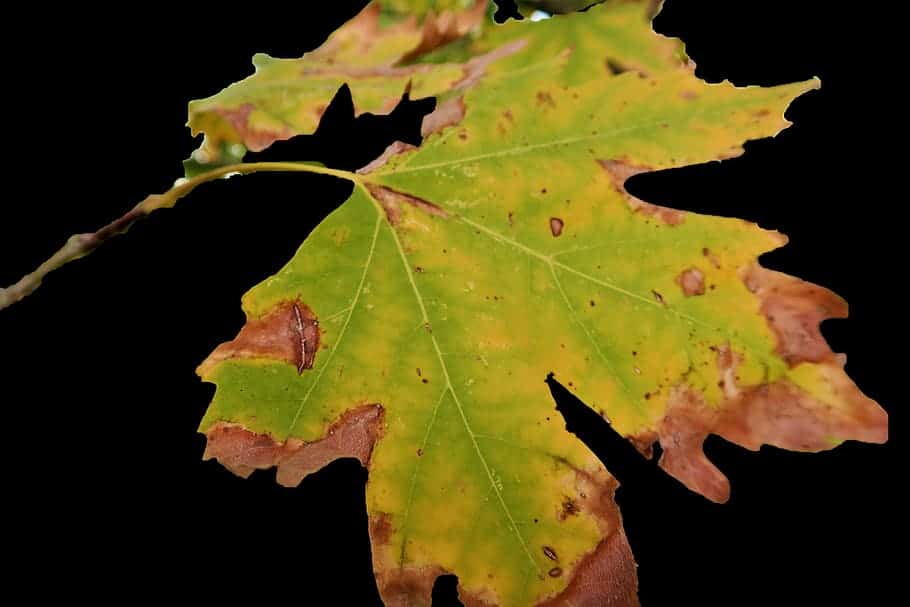 Verticillium or Verticillium wilt is a common soil fungus that thrives in temperate climates around the world and can be present in the soil for decades.
Verticillium or Verticillium wilt is a common soil fungus that thrives in temperate climates around the world and can be present in the soil for decades.
Verticillium wilt overwinters in the soil as dormant mycelium or tiny dormant black structures called microsclerotia, waiting for favorable conditions to return.
They enter damaged plant tissue through the roots and multiply. Many common weeds, such as dandelions and weeds, can be Verticillium host species.
Verticillium wilt is a disease that affects more than 350 species of eudicolous plants. It is caused by six species of Verticillium fungi: Verticillium dahliae, Verticillium albo-atrum, Verticillium longisporum, Verticillium nubilum, Verticillium theobromae, and Verticillium tricorpus.
Many plants with significant economic weight are susceptible, such as cotton, tomatoes, potatoes, oilseed rape, aubergines, peppers, and ornamental plants, as well as others in natural vegetation communities.
Many species and cultivars of eudicots are resistant to the disease, and all monocots, gymnosperms, and ferns are immune. To know more: Verticillium wilt in the Orchard: What is it? How do we identify it?
Properties and benefits of walnuts
Walnuts are part of the family of nuts with the highest amount of beneficial elements for human consumption. It is currently considered a super food.
Within these we have:
- They help control cholesterol levels in the body, providing good cholesterol and reducing bad cholesterol.
- They are an excellent companion when working on weight reduction because they improve the metabolic process.
- They exert a positive work in the control of diabetes.
- They have elements that reduce body inflammation.
- They allow better absorption of calcium and, therefore, improve the health of the bones.
- They restrict the growth of cancer cells in the body.
- They facilitate the process of falling asleep.
- Other important data lies in its composition because it includes vitamins, minerals, fats, proteins, carbohydrates and caloric energy.
How long does a walnut tree live?
The walnut is characteristic for being a fairly long-lived tree capable of exceeding up to 500 years of life.
How long does it take for a walnut tree to grow?
It is a tree that grows quickly developing a complete root system and a good height after 7 years.
Even at that age it would be considered an adult specimen.
Can it be grown in a pot?
Yes, you can grow walnut trees in a pot, noting that its growth will not be as prominent as when it is in the ground.
It is also important to point out that in these cases it is necessary to pay close attention to the composition of the substrate and care such as irrigation, fertilization and pruning.
How many times does a walnut tree produce fruit?
Walnut production is annual and generates around 30 kilos per year.
However, bi-annual processes are the ones that offer the best results, increasing that average to 150 kilos of nuts.
Should a walnut tree be pollinated to obtain fruit?
The walnut tree does need the pollination process to create fruit.
The good news is that each specimen has male and female flowers to achieve this goal.
In addition, it does not require the presence of pollinators because the entire process is generated by the action of the wind.
How cold can a walnut tree tolerate?
The walnut is a tree of warm climates to which the cold can be harmful. Ideally, it should be above 21 ° C to ensure its growth.
In winter, temperatures should not drop below -5° C because they will make you suffer.
How many walnut trees can be planted per hectare?
Walnut trees can be worked with up to 450 specimens per hectare.
What kind of fertilizer does a walnut tree need?
Walnut fertilization is carried out based on the three main macronutrients: nitrogen, phosphorus and potassium, plus magnesium.
What is recommended by specialists is to work according to these proportions 120-60-100-40.
How much heat and/or drought can a walnut tree tolerate?
It is a species capable of withstanding a hot climate, but without overdoing it. More than 38° C will be harmful.
It does not do well with droughts, even though after being an adult specimen it could withstand some time without irrigation.
Bibliographic references
- Deficit irrigation of walnut trees, R Ferreyra, P Gil, P Maldonado – 2003 – library.inia.cl
- Drip irrigation of walnut ( Juglans regia l.) in Barda de Patagones, EN Lui, RA Bouhier, S Gallo, RM Martínez… – Pilquen-Section…, 2005 – dialnet.unirioja.es
- Irrigation scheduling in pecan walnut (Carya illinoinensis), using an integral model based on thermal time, E Sifuentes Ibarra, JA Samaniego Gaxiola… – Revista mexicana de…, 2015 – scielo.org.mx
- Water function and fruit production of walnut trees in semi-arid zones: application to irrigation management, M Cohen – 1996 – dialnet.unirioja.es
- Effect of the irrigation system and climate on the water use efficiency of pecan trees, A Zermeño González, CI Cruz Santes… – Terra…, 2014 – scielo.org.mx
- Effect of the irrigation layer on the radial growth of the pecan tree (Carya illinoensis Koch) through image analysis, GG Cervantes, JV Díaz, IO Castillo… – Agrofaz: publication…, 2005 – dialnet.unirioja.es



![Photo of Tuta Absoluta o Polilla del Tomate: [Cómo Identificarla y Combatirla]](https://www.complete-gardening.com/wp-content/uploads/2022/08/tuta-absoluta-o-polilla-del-tomate-como-identificarla-y-combatirla.jpg)
![Photo of Sow Kale: [Substrate, Care, Irrigation, Pests and Diseases]](https://www.complete-gardening.com/wp-content/uploads/2021/06/kale_1596697041-390x220.jpg)